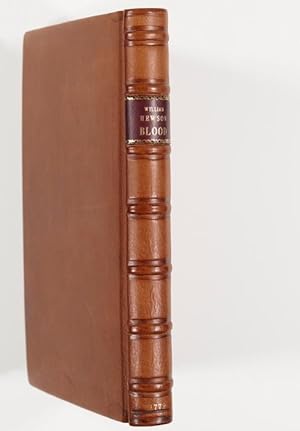About this Item
London: Printed for T. Cadell in the Strand, 1772, 8°, XVI, 223, (1) pp., feiner Ledereinband im Stil d.Zt. Second Edition of "An Experimental Inquiry into the Properties of the Blood", with some Remarks, on its Morbid Apperarances, ." (1771, 12 °), and first of the 8vo edition "Experimental Inquiries : Part the First. Being a Second Edition of an Inquiry into the Properties if the Blood. With Remarks of some of its Morbid Appearances: And an Appendix, relation to The Discovery of the Lymphatic System in Birds, Fish, and the Animals called Amphibious. By William Hewson, F.R.S. and Teacher of Anatomy " . "Since the publication of the first Edition some new experiments have been made, and a new chapter has been added, which contains a recapitulation of the principal facts and conclusions that are met with tis Essay. These additions are between p.98 and 140. The Appendix is a vindication of the Author's right to the discovery of the Lymphatic vessels, in opposition to the claim of the learned Dr. Alexander Monro, Professor of Anatomy in the University of Edinburg." Preface, p.VIII William Hewson (1739-1744), "was an English surgeon, anatomist, and lecturer. As a result of his investigations he wrote several books and papers, one of the most important of which was his Inquiry into the Properties of the Blood. He made two important contributions: The description of fibrinogen and defibrinated blood; a clarification of the nature and function of the white blood corpuscles. In this small work he showed the essential character of the process of coagulation, and described the forms of red corpuscles in different animals." Hewson's discussion of fibrinogen is on pp. 5-6 (pp.6-7 1st. Ed. 1771) of his Inquiry: "It is well known, that the crassamentum consists of two parts, of which one gives it solidity, and is by some called the fibrous part of the blood, or the gluten, but by others with more propriety termed the coagulable lymph; and of another, which gives the red colour to the blood, and is called the red globules. These two parts can be separated by washing the crassamentum in water, the red particles dissolving in the water, whilst the coagulable lymph remains solid. That it is the coagulable lymph, which, by its becoming solid, gives firmness to the crassamentum, is proved by agitating fresh blood with a stick, so as to collect this substance on the stick, in which case the rest of the blood remains fluid." Experimentum II, (pp.4-8). The "discovery" of the white corpuscles consisted of a gradual realization that the formed objects observed in the blood were of two kinds, one red and one clear. By the middle of the eighteenth century the white corpuscles had been mentioned many times. Hewson did the first accurate and significant work on the white blood corpuscles, describing them and relating them with the lymphatics and with pus formation. On pp. 141-142 ( Chapter 5, pp.115-116 1st.Ed. 1771) of his Inquiry he writes: ". I have examined it in a microscope with a pretty large magnifier, and have found it to contain a number of very small globules, although naturally when transparent, no globules can be observed in it, notwithstanding what has been affirmed by some authors. These globules differ from the red particles (improperly called globules) in their size, which is much smaller; and likewise in their shape, which is spherical, whilst the red particles are flat. They agree more with the globules of milk. I have compared them with those of woman's milk, and have found, that in the milk the globules are of different sizes, some being three or four times as large as others, and the smallest little more than just visible, when viewed with a lense of 1/23 of an inch focus, whilst those of the white serum are more regular, and are all of them about the size of the smallest globules of milk. . . . " Chapter VI. Of the serum of the blood, and particularly of the milk-like Serum / Of the . Seller Inventory # 60664
Contact seller
Report this item
![]()

